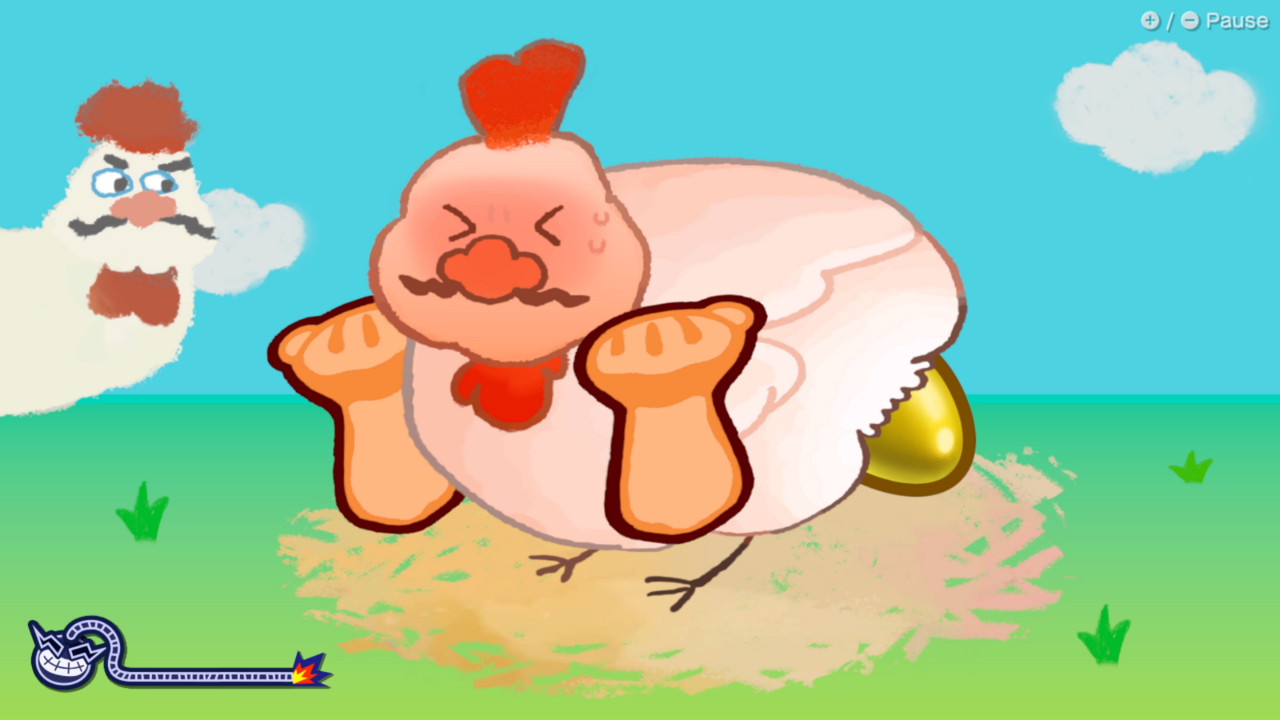WarioWare is a series built on gimmicks. The very idea of “microgames” on the Game Boy Advance was a silly, novel idea, and every iteration since then has tried to match that gonzo style. At this point, the real measure of a WarioWare game is how well the new schtick works to deliver its frenetic rapid-fire games. For WarioWare: Move It, Nintendo has repeated the pose-based games from the Wii’s WarioWare: Smooth Moves. But while the games are as wacky as ever and frequently hilarious, many of the poses (or “Forms”) themselves are too complex–which creates friction for the players and sometimes even for the Joy-Con controllers.
The unusual nature of the pose mechanic is apparent right away when the game asks you to acclimate yourself to holding the Joy-Con controller in a wonky sideways position: face buttons inside your palm or facing outward, controller turned to the side so that your thumb is positioned to hit the ZL or ZR button. If you imagine you’re on a gameshow like Jeopardy where the contestants have buzzers, that’s basically how this feels. You can’t really reach the face buttons, but you don’t need them. Instead, everything is controlled by motion, sometimes also involving the ZL and ZR button, and very rarely, the SL and SR buttons located on the rail.
The odd hand positioning appears to be in service of better motion sensing, allowing for a wider range of poses than we saw in Smooth Moves on the Wii. And to its credit, the gameplay does get a lot of mileage out of finding new ways to integrate these poses into different types of competitions. You might be asked to switch from holding your forearms perpendicular to your body (Choo-Choo) to putting your hands up at your cheeks (Lovestruck) to posing with one hand at your head and another at your side (Fashionista). What’s most impressive about the array of poses is how often Move It makes them feel natural in the context of the microgames. The game won’t know if you aren’t playing along fully, but you’ll naturally perform the motions better if you commit to the bit.
And much more than Smooth Moves, this particular iteration of a motion-based WarioWare feels experimental. The Hand Model Form, for example, has you pass a controller along to your non-dominant hand and then use its infrequently leveraged IR sensor to detect the movements of your dominant hand. The game is also counting on you to have kept track of your Joy-Con straps, in part because the attachment makes the SL/SR buttons more prominent, but mostly because some games will prompt you to drop your controller. One pose, Pounce, even has you place the controllers on a flat surface so they can be flipped, spun, or otherwise manipulated that way.
Unfortunately, the variety of poses and how they’re approximated by the motion controls are also where WarioWare starts to meet its limitations. The idea of microgames has always been rapid-fire challenges, in which quickly figuring out what you’re supposed to be doing is a key part of the game and the fun. But the poses add a wrinkle to that–the Joy-Cons aren’t great at detecting your motions for certain poses, which means you might frequently fail even when performing the move as shown. The problem is further compounded when you don’t quickly understand what’s being asked of you. There were microgames that I repeated three or four times and I frustratingly didn’t know if I was doing something wrong or if the controller wasn’t registering my movements.
The Pounce pose, for instance, gave me an issue in a boss stage where I was supposed to be a pair of robotic hands flipping steaks. It wasn’t detecting my flips fast enough, leading to burned steaks and having to start the whole stage over–and since it was a boss stage, it was relatively lengthy compared to the other microgames. The aforementioned Hand Model, while a neat idea in concept, is almost always stymied by the limitations of the IR sensor.
Outside of having to repeatedly tackle a boss stage, though, there’s little penalty for failure in the Story mode. That’s because of a new “Second Chance Stance” mechanic, which functionally eliminates the life counter. You still have four pips of health per stage, but if you fail out of a microgame series, you can just adopt a short pose, hold it for three seconds, and you’re back where you left off with your health fully restored. It’s a smart addition that makes failure less punishing, but it also feels like a concession to the imprecision of the motion controls. It’s as if the game understands you’ll probably fail at least once or twice by no fault of your own, so hey, just remove the penalty for failure too.
Since you need to learn a series of poses to know how to play the game, the Story mode walks you through them a few at a time. These bundles of stages are broken up by character in the usual WarioWare fashion, but this time you’ll also see that a set of stages will teach you a couple of new poses too. So as you make your way through the randomized microgames, it detects the first time you encounter a new pose and gives you a short, humorous interstitial moment to explain the new Form. This can be a bit of a momentum killer for the usually brisk pace of a WarioWare game, but it’s only the first time and works well enough to ease you in.
The game won’t know if you aren’t playing along fully, but you’ll naturally perform the motions better if you commit to the bit.
In fact, the entire Story mode is an extended tutorial, walking you through the various poses even as it eliminates the risk of failing out thanks to the Second Chance Stance. It tells a breezy story about Wario winning a trip to a resort island and reluctantly bringing along the rest of his crew. It’s more vibes than an actual plot, but it does package the wacky, irreverent humor of the microgames nicely. Wario’s new voice, following the departure of longtime actor Charles Martinet, is mildly distracting as someone very familiar with the original. And the story is very short, maybe 2-3 hours for the critical path, so I finished it in two sittings. You can always replay sets of stages to unlock all of the microgames, of course.
The real longevity of the game is supposed to be in its array of multiplayer modes, which are plentiful. This is first and foremost a party game, as evidenced by “Party” being right there on the home menu, just as prominently displayed as the story mode. The Party mode has a combination of games from the Story mode, as well as its own specially designed competitive microgames. But putting this into the party rotation presents its own challenges.
For one thing, the Story mode does function as a tutorial, but that also means that visitors who haven’t already played it may feel lost. I tried playing with two children and frequently had to pause to explain a Form or microgame they hadn’t seen before. This problem could work itself out given enough time and experience, but if people aren’t having fun because they feel confused by the microgames in the first place, they may not want to continue long enough to get their bearings. You can play the Story mode with two players–with a mixture of taking turns, simultaneous play, and bailing each other out if one of you fails a game–which could help alleviate the problem somewhat.
The bigger problem in my experience was when a Party game simply refused to work. In one mode modeled after a space-themed board game, we kept running into a particular microgame that asked for the Big Cheese pose (hands on your hips). One of the controller inputs simply refused to read the pose and nothing I did–not switching controllers nor recalibrating nor repositioning–seemed to help. Since the next microgame wouldn’t begin until it detected all of the players in the Big Cheese pose, and there was no option to skip it and move on to another, we were just stuck. We had to quit that Party mode game and try another. We ultimately did get it to work on a subsequent try, but we still have no idea what went wrong the first time.

Gallery
Aside from the detection issues, the board game mode was frustrating because it presented the illusion of a competitive game, but it didn’t act like one. Points would get randomly redistributed, and player positions would be swapped regularly. I understood this just meant the board game wrapping was a thin pretense to play a bunch of microgames, and the winning didn’t actually matter, but that’s a difficult concept to explain to kids who don’t understand why the game just gave all their hard-earned points to the other players.
There are a wide array of Party modes to choose from, though, and I preferred the others. One especially primed for parties is the Listen to the Doctor mode, which mixes the games with other wacky real-life commands. So you not only have to complete the microgames themselves, but you also have the other players rating how well you listened to the commands and played along. That sort of game, where you’re rewarded for freeing your inhibitions, is well-tuned for a party. Another mode, based on the monster Medusa, has you race toward her while accomplishing the microgames to defeat her minions. This one worked well but seemed geared toward a competitive nature. And still another game, Copycat Mirror, has one player with a controller face away from the TV, and imitate the movements of another player who has no controller–but backwards, since it’s a mirror. Like the doctor game, it’s centered around playful silliness.
Those moments in WarioWare: Move It show how the game is capable of hitting its stride, and it’s hard not to get a goofy grin when you’re asked to cock your head to one side to gaze into a lover’s eyes, or stamp a series of papers with your butt. But those moments are not as frictionless as they should be for a game that seems aimed at a relaxed, party atmosphere. The original WarioWare had an elegant simplicity to it, and the motion controls add a layer of abstraction that can be difficult to penetrate. If your friend circle is willing to put in the time to learn all the poses–and deal with some potential technical hiccups–then you may have a good time. But I suspect that, for most, WarioWare: Move It will be a short-lived Story mode experience before the game moves its way to the shelf.

